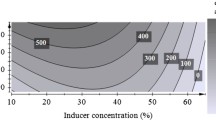Abstract
The zygomycete Rhizopus oryzae sb is a very efficient organism for retting of flax, the initial microbiological step in the process of making linen. An extracellular polygalacturonase, when isolated could perform retting, and therefore probably is the key component in the retting system of R. oryzae. This was purified and characterized. The purified enzyme has a molecular mass of 37,436 Da from mass spectrometric determination, an isoelectric point of 8.4, and has non-methylated polygalacturonic acid as its preferred substrate. Peptide sequences indicate that the enzyme belongs to family 28, in similarity with other polygalacturonases (EC. 3.2.1.15). It contains, however an N-terminal sequence absent in other fungal pectinases, but present in an enzyme from the phytopathogenic bacterium Ralstonia solanacearum. The biochemical background for the superior retting efficiency of R. oryzae sb is discussed.




Similar content being viewed by others
References
Akin DE, Morrison WH III, Gamble GR, Rigsby LL, Henriksson G, Eriksson KEL (1997) Effect of retting enzymes on the structure and composition of flax cell walls. Text Res J 67:279–287
Akin DE, Rigsby LL, Henriksson G, Eriksson KEL (1998) Structural effects on flax stems by three potential retting fungi. Text Res J 68(7):515–519
Akin DE, Slomczynski D, Rigsby LL, Eriksson KEL (2002) Retting flax with endopolygalactouronase from Rhizopus oryzae. Text Res J 72(1):27–34
Bateman DF, Beer SV (1965) Simultaneous production and synergistic action of oxalic acid and polygalacturonase during pathogenesis by Sclerotium rolfsii. Phytopathology 55:204–211
Dahlman O, Rydlund A, Lindquist A (1997) Characterization of carbohydrates from chemical pulps using capillary electrophoresis and MALDI-TOF-MS. The 9th international symposium on wood and pulping chemistry, Montreal, Canada
Dujardin A (1942) Vlas roten. De Westvlaamsche Boekhandel s.v. Groeninghe drukkerij, Kortrijk
Green F, Clausen CA, Kuster TA, Highley TL (1995) Induction of polygalacturonase and the formation of oxalic acid by pectin in brown-rot fungi. World J Microbiol Biotechnol 11:519–524
Hellman U, Wernstedt C, Gonez J, Heldin CH (1995) Improvement of an in-gel digestion procedure for the micropreparation of internal protein-fragments for amino-acid sequencing. Anal Biochem 224:451–455
Henriksson G, Akin DE, Hanlin RT, Rodriguez C, Archibald DD, Rigsby LL, Eriksson KEL (1997) Identification and retting efficiencies of fungi isolated from dew-retted flax in the United States and Europe. Appl Environ Microbiol 63(10):3950–3956
Henriksson G, Akin DE, Rigsby LL, Patel N, Eriksson KEL (1997) Influence of chelating agents and mechanical pretreatment on enzymatic retting of flax. Text Res J 67(11):829–836
Henriksson G, Akin DE, Slomczynski D, Eriksson KEL (1999) Production of highly efficient enzymes for flax retting by Rhizomucor pusillus. J Biotechnol 68:115–123
Henrissat B (1991) A classification of glycosyl hydrolases based on amino acid sequence similarities. Biochem J 280:309–316
Huang J, Schell MA (1990) DNA Sequence analysis of pglA and mechanism of export of its polygalacturonase product from Pseudomonas solanacearum. J Bacteriol 172:3879–3887
Johansson G, StÅhlberg J, Lindeberg G, Engström Å, Pettersson G (1989) Isolated fungal cellulose terminal domains and a synthetic minimum analogue bind to cellulose. FEBS Lett 243:389–393
Maizel JV (1969) Fundamental techniques in virology. In: Habel K, Salzmann NP (eds) Academic, New York, pp 334–362
Merril CR, Goldman D, van Keuren ML (1984) Gel protein stains: silver stain. Methods Enzymol 104:441–447
Miller GL (1959) Use of dinitrosalicylic acid reagents for determination of reducing sugars. Anal Chem 31:426–428
Rognes H, Gellerstedt G, Henriksson G (2000) Optimization of flax fiber separation by leaching. Cellulose Chem Technol 34:331–340
Rosenfeld J, Capdevielle J, Guillemot JC, Ferrara P (1992) In-gel digestion of proteins for internal sequence-analysis after 1-dimensional or 2-dimensional gel-electrophoresis. Anal Biochem 203:173–179
Saito K, Takakuwa N, Oda Y (2004) Purification of the extracellular pectinolytic enzyme from the fungus Rhizopus oryzae NBRC 4707. Microbiol Res 159(1):83–86
Sakai T, Sakamoto T, Hallaert J, van Damme EJ (1993) Pectin, pectinase and protopectinase: production, properties and applications. Adv Appl Microbiol V 39:213–294
Sharma HSS (1988) Chemical retting of flax using chelating compounds. Ann Appl Biol 113:159–165
Sharma HSS, van Sumere CF (1992) The biology and Processing of flax. M Publications, Belfast, pp 157–198
Szabo IJ, Johansson G, Pettersson G (1996) Optimized cellulase production by Phanerochaete chrysosporium: control of catabolite repression by fed-batch cultivation. J Biotechnol 48:221–230
Thakur BR, Singh RK, Handa AK (1997) Chemistry and uses of pectin—a review. Crit Rev Food Sci Nutr 37(1):47–73
Turner NA, Needs EC, Khan JA, Vulfson EN (2001) Analysis of conformational states Candida rugosa lipase in solution: implications for mechanism of interfacial activation and separation of open and closed forms. Biotechnol Bioeng 72(1):108–118
Van Sumere CF, Sharma HSS (1991) Analysis of fine flax fiber produced by enzymatic retting. Asp Appl Biol 28:15–20
Van Sumere CF (1992) Retting of flax with special reference to enzymatic retting. In : Sharma HSS, van Sumere CF (eds) The biology and processing of flax. M Publications, Belfast, pp 157–198
Vogel HJ (1964) Distribution of lysine pathways among fungi: evolutionary implications. Am Nat 98:435–446
Zhang J, Henriksson G, Johansson G (2000) Polygalacturonase is the key component in enzyme retting of flax. J Biotechnol 81:85–89
Zhang J, Johansson G, Pettersson B, Akin DE, Foulk JA, Khalili S, Henriksson G (2003) Effects of acidic media pre-incubation on flax enzyme retting efficiency. Text Res J 73(3):263–267
Acknowledgements
The Swedish Pulp and Paper Research Foundation supported this work. The Wallenberg Consortium North for Functional Genomics financed the mass spectrometer at AlbaNova University Centre/Royal Institute of Technology. We thank Dr. Evert Karlsson, Uppsala University, for important discussions about separation artifacts.
Author information
Authors and Affiliations
Corresponding author
Rights and permissions
About this article
Cite this article
Zhang, J., Henriksson, H., Szabo, I.J. et al. The active component in the flax-retting system of the zygomycete Rhizopus oryzae sb is a family 28 polygalacturonase. J IND MICROBIOL BIOTECHNOL 32, 431–438 (2005). https://doi.org/10.1007/s10295-005-0014-y
Received:
Accepted:
Published:
Issue Date:
DOI: https://doi.org/10.1007/s10295-005-0014-y




